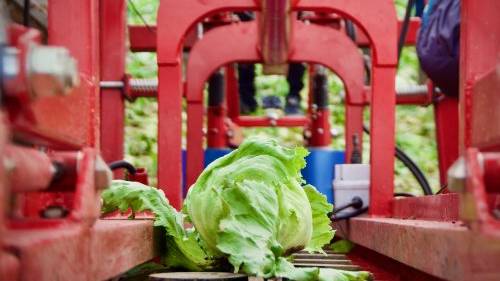Robotic solution uses machine vision and artificial intelligence to automate lettuce harvesting
Lettuce is a valuable crop in Europe and the USA. But labor shortages are making harvesting this valuable field vegetable difficult, as finding enough seasonal labor to meet harvesting obligations is one of the sector's biggest challenges. Also, because wage inflation is rising faster than producer prices, margins are very small.
In England, agricultural technology and engineering specialists are working with IDS Imaging Development Systems GmbH (Obersulm, Germany) to develop a robotic solution to automate lettuce harvesting. The team is working on a project funded by Innovate UK and includes experts from the Grimme farm equipment factory, Agri-EPI Center (Edinburgh, UK), Harper Adams University (Newport, UK), Western University Machine Vision Center. England (Bristol) and the UK's two largest salad producers, G's Fresh and PDM Produce.
 Machine vision and AI are used to determine the exact point of intersection on the stem.
Machine vision and AI are used to determine the exact point of intersection on the stem.
As part of the project, existing leek harvesting equipment is adapted to lift the lettuce from the ground and grab it between the pressure bands. The outer or "wrapper" lettuce leaves will be mechanically removed to expose the stem. Machine vision and artificial intelligence are then used to determine the exact cut point on the stalk to carefully separate the head of the lettuce.
“According to colleagues from Salad Harvesting Services Ltd., a subsidiary of G, the iceberg cutting process is the most technical step in the automation process,” explains IDS product sales specialist Rob Webb. “The cleaning robot prototype being created includes a GigE Vision camera from the uEye FA family. It is considered to be particularly robust and therefore ideal for difficult conditions. “Because this is an outdoor application, an IP65/67 enclosure is required,” Webb notes.
The choice fell on the GV-5280FA-C-HQ model with a compact 2/3″ IMX264 global shutter CMOS sensor from Sony.
“The sensor was chosen mainly for its versatility. We don't need full resolution for AI processing, so sensitivity can be increased with binning. The larger sensor format means that wide-angle optics are also not needed,” Rob Webb summed up the requirements. In the application, the CMOS sensor convinces with excellent image quality, light sensitivity and an exceptionally wide dynamic range, and delivers near-silent, high-contrast 5-megapixel 5:4 images at 22 frames per second – even in applications with variable lighting conditions. .
A wide range of accessories such as lens tubes and trailing cables are as durable as the camera body and screw-on connectors (X-coded 8-pin M12 connector and 8-pin Binder connector). Another benefit: Built-in camera functions such as pixel pre-processing, LUTs or gamma minimize the required computer power.
A prototype robotic lawnmower will be used for field trials in England towards the end of the 2021 season. “We are happy to participate in the project and look forward to the results. We are convinced of its potential to automate and increase the efficiency of lettuce harvesting, not only in terms of compensating for the lack of seasonal workers,” says Jan Hartmann, Managing Director of IDS Imaging Development Systems GmbH.
The challenges facing the agricultural sector are indeed complex. According to the Food and Agriculture Organization of the United Nations (FAO), by 2050, agricultural productivity should increase by almost 50 percent compared to 2012 due to a sharp increase in population. This yield expectation means a huge challenge for the agriculture industry, which is still in its infancy in terms of digitalization compared to other sectors and is already under heavy pressure to innovate due to climate change and labor shortages.
The agriculture of the future is based on networked devices and automation. Cameras are an important building block, and artificial intelligence is the central technology. Intelligent applications such as cleaning robots can make a significant contribution to this.